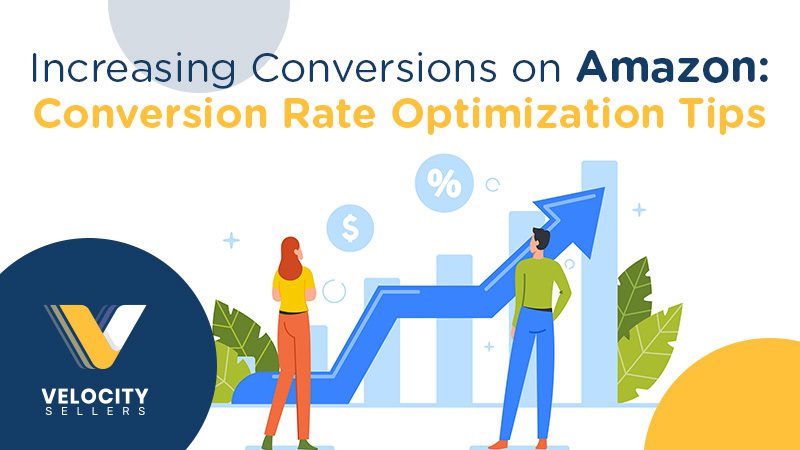Conversion rate optimization is pivotal in maximizing success on the Amazon platform. As the world’s largest online marketplace, Amazon offers immense opportunities for sellers and businesses to showcase their products to a vast customer base. However, the accurate measure of success lies in converting those visitors into customers. A high conversion rate would mean that a significant percentage of visitors who view the product listing make a purchase. This generates immediate sales and establishes customer trust and loyalty, leading to potential repeat purchases and positive reviews.
On the other hand, a low conversion rate indicates a missed opportunity to capitalize on the product’s potential. By implementing effective conversion rate optimization strategies, such as optimizing product listings, leveraging social proof, and enhancing the shopping experience, sellers can significantly increase their chances of turning browsing customers into engaged buyers, driving revenue growth, and establishing a strong presence on Amazon. In this article, we will delve into the significance of conversion rate optimization on Amazon and explore practical tips and strategies to increase conversions, ultimately maximizing sales and fostering long-term success.
Understanding Amazon’s Algorithm
- Overview of Amazon’s A9 algorithm
- Factors influencing search rankings and Conversions on Amazon
- Importance of optimizing product listings for visibility and discoverability
To effectively optimize conversions on Amazon, it is crucial to have a solid understanding of the platform’s A9 algorithm. The A9 algorithm, developed by Amazon, delivers relevant search results to customers. It takes into account several factors that influence search rankings and visibility.
Here are some critical aspects of the A9 algorithm:
Product Relevance: The algorithm assesses how well a product matches a customer’s search query. Optimizing product listings with relevant keywords and ensuring accurate and descriptive titles, bullet points, and descriptions can improve product relevance.
Customer Reviews: The A9 algorithm considers customer reviews to measure product quality and customer satisfaction. Positive reviews contribute to higher search rankings and conversions. Encouraging customers to leave reviews and providing exceptional customer service is vital for building a positive reputation.
Pricing and Competitiveness: Competitive pricing can impact search rankings and conversions. The algorithm considers factors such as price competitiveness, including discounts, special offers, and competitive pricing strategies.
Product Availability: A product’s availability and stock levels influence search rankings. Ensuring product availability and managing inventory effectively can positively impact visibility and conversions.
Sales Velocity: The A9 algorithm considers the sales velocity of a product, which refers to how quickly a product sells. Higher sales velocity can improve search rankings, indicating popularity and demand.
Seller Performance Metrics: The algorithm considers seller performance metrics, such as order defect rate, late shipment rate, and customer feedback. Maintaining excellent seller performance is crucial for achieving higher search rankings and conversions.
Several vital factors significantly influence both search rankings and conversions on Amazon. Understanding these factors allows sellers to develop effective strategies for increasing conversions.
Let’s consider some essential factors to consider:
Product Relevance: Optimizing product listings with relevant keywords, informative titles, and accurate descriptions increases the chances of ranking higher in search results. Aligning the product content with customer search queries enhances relevance.
Customer Reviews: Positive customer reviews contribute to higher search rankings and conversions. Encouraging customers to leave reviews and providing exceptional customer service can significantly impact a product’s performance.
Pricing Competitiveness: Competitive pricing can influence both search rankings and conversions. Factors such as discounts, promotions, and price adjustments can attract customers and improve sales.
Product Availability: A product’s availability and stock levels impact its search rankings. Ensuring product availability and managing inventory effectively are crucial for maintaining visibility and driving conversions.
Sales Velocity: The speed at which a product sells, also known as sales velocity, affects search rankings. A higher sales velocity indicates popularity and demand, leading to improved visibility and conversions.
Seller Performance Metrics: Maintaining excellent seller performance is essential for higher search rankings and conversions. Factors such as order defect rate, late shipment rate, and customer feedback contribute to the overall performance of a seller on the platform.
Optimizing product listings is a fundamental aspect of increasing conversions on Amazon. Selling can improve visibility and discoverability by strategically optimizing product listings, ultimately driving conversions.
Some essential elements to focus on:
Keyword Optimization: Conduct thorough keyword research to identify relevant and high-converting keywords. Incorporate these keywords naturally into product titles, bullet points, descriptions, and backend search terms to improve visibility in search results.
Compelling Titles: Craft clear and informative product titles that accurately represent the product and include relevant keywords. A well-crafted title can attract attention and increase click-through rates.
Persuasive Descriptions: Write compelling and detailed product descriptions highlighting the product’s features, benefits, and unique selling points. Use precise language, bullet points, and formatting to make the information easily scannable for potential customers.
High-Quality Images and Videos: Utilize high-resolution product images and videos that showcase the product from different angles and demonstrate its functionality. High-quality visuals help customers make informed purchasing decisions and increase trust.
Clear Product Information: Provide clear and concise product information, including specifications, dimensions, and other relevant details. Accurate and comprehensive information helps customers understand the product and reduces the likelihood of returns or negative reviews.
Unique Selling Proposition: Highlight the product’s unique selling points to differentiate it from competitors. Emphasize what makes the product unique, such as eco-friendliness, durability, or exclusive features.
Enhanced Brand Content (EBC): Utilize Amazon’s Enhanced Brand Content feature to create visually appealing and informative product descriptions. EBC allows sellers to include additional images, text, and multimedia to enhance the shopping experience.
Conducting Market Research

- Identifying target audience and their preferences
- Analyzing competitors and their strategies
- Gathering customer feedback and reviews
Unveiling the secrets of your target audience and understanding their preferences is a crucial step in optimizing conversions.
Here are the key strategies to conduct thorough market research:
Demographic Insights: Gather data on age, gender, location, and other relevant demographic information to gain a clear picture of your target audience. For example, discovering that your primary audience consists of tech-savvy millennials living in urban areas can shape your optimization strategies accordingly.
Psychographic Analysis: Dive into the mindset of your audience by exploring their interests, values, and lifestyle choices. Understanding their motivations and aspirations helps you align your messaging and offerings with resonating with their desires.
Purchasing Behavior Patterns: Analyze how your target audience behaves when making purchasing decisions. Do they prioritize affordability or quality? Are they early adopters or cautious buyers? This insight allows you to tailor your optimization strategies to meet their needs and preferences.
Analyzing competitors and their strategies is crucial, as studying their tactics provides valuable insights to refine your approach.
Let us delve into the process of conducting a comprehensive competitive analysis, allowing us to obtain a strategic advantage in the marketplace:
Product and Pricing Assessment: Evaluate your competitors’ product offerings, pricing strategies, and promotions. Identify unique selling points and pricing tactics that attract customers. For example, consider incorporating similar techniques into your marketing efforts if a competitor offers free shipping or limited-time discounts.
Marketing and Advertising Examination: Analyze how your competitors position their brands and engage with customers through marketing channels. Look for successful social media campaigns, influencer partnerships, or content marketing strategies. Learn from their successes and adapt them to fit your brand’s unique voice and audience.
Customer Engagement Evaluation: Observe how competitors interact with their customers online and offline. Examine their customer service, user experience, and community engagement. Identify areas where you can improve and differentiate your brand, such as offering exceptional customer support or creating engaging user-generated content campaigns.
Utilizing the invaluable power of customer feedback and reviews is essential for maximizing conversions.
Let’s explore effective methods to collect and leverage this valuable information:
Feedback Collection Channels: Implement various channels to gather customer feedback, such as post-purchase surveys, email inquiries, or social media listening. Encourage customers to share their opinions and experiences to gain valuable insights.
Review Monitoring: Regularly monitor customer reviews across platforms. Pay attention to positive and negative reviews to identify strengths and weaknesses in your offerings. Address concerns promptly and use constructive feedback to enhance your products or services.
Testimonials and Social Proof: Leverage positive reviews and testimonials as social proof on your website and product pages. Highlight specific customer success stories and showcase how your offerings have positively impacted their lives. This builds trust and confidence among potential customers.
Continuous Improvement: Actively use customer feedback to iterate and improve your offerings. Make data-driven decisions based on customer preferences and address any pain points or areas for enhancement. This ongoing process of refinement demonstrates your commitment to customer satisfaction.
By conducting comprehensive market research, analyzing competitors, and leveraging customer feedback, you gain valuable insights to optimize your strategies and increase conversions. Understanding your target audience, staying ahead of your competitors, and continuously improving based on customer feedback are the keys to success in the dynamic world of SEO and digital marketing.
Optimizing Product Listings
- Writing compelling product titles
- Crafting persuasive product descriptions
- Utilizing high-quality product images and videos
- Optimizing product reviews and ratings
The art of creating compelling product titles lies in captivating potential buyers from the very first glance.
Here are some professional strategies to optimize your product titles:
Strategic Keyword Integration: Through meticulous keyword research, identify relevant and high-performing keywords that resonate with your target audience. For example, if you’re selling fitness equipment, consider incorporating keywords like “durable,” “high-performance,” or “versatile” to attract fitness enthusiasts.
Concise and Informative: Craft titles that convey essential product information concisely while igniting curiosity. For instance, instead of “Men’s Running Shoes,” a more compelling title could be “Premium Lightweight Men’s Running Shoes for Enhanced Performance and Comfort.”
Persuasive product descriptions are vital for converting visitors into customers.
Elevate your reports with these professional techniques:
Customer-Centric Approach: A customer-centric approach involves putting yourself in the shoes of your target audience and addressing their needs directly. Understanding their pain points and preferences allows you to tailor your product listings to create a personalized and compelling experience. Focus on highlighting how your product solves their problems and improves their lives, using language that resonates with them. Anticipate and answer their questions, providing detailed information and benefits that speak directly to their concerns. This customer-centric approach builds trust and increases the likelihood of conversions and customer loyalty.
Compelling Language: Utilize persuasive and engaging language to captivate readers. Instead of simply stating features, focus on benefits. For instance, highlight how noise-canceling headphones create an immersive listening experience by blocking distractions, allowing users to enjoy their favorite music in pristine clarity.
Visually appealing and informative product images and videos are vital in driving conversions.
Essential steps on how to optimize them effectively:
Professional Visual Assets: Invest in high-quality product photography that showcases your offerings in the best light. For example, if you’re selling furniture, provide multiple high-resolution images showcasing different angles, close-ups of intricate details, and lifestyle shots to help potential buyers envision the product in their own space.
Engaging Product Videos: Create informative and captivating videos demonstrating your product’s features, functionality, and benefits. For instance, if you’re selling kitchen appliances, produce videos showcasing your products’ ease of use, time-saving capabilities, and versatility through recipe demonstrations or cooking tutorials.
Positive reviews and ratings act as social proof, building trust and confidence among potential buyers.
Consider these professional strategies for optimizing product reviews:
Encourage Honest Feedback: Actively encourage customers to leave honest reviews by sending personalized follow-up emails after purchase. Offer incentives, such as exclusive discounts on future purchases or entry into a giveaway, to motivate customers to share their experiences.
Monitor and Respond: Regularly monitor customer reviews and ratings to gain insights into your product’s strengths and weaknesses. Respond promptly and professionally to positive and negative feedback, addressing concerns and showcasing your commitment to customer satisfaction.
Highlight Positive Reviews: Showcase positive reviews prominently on your product listings. Pull out compelling snippets or testimonials highlighting your product’s key benefits and exceptional customer experiences.
By optimizing your product listings through compelling titles, persuasive descriptions, high-quality visuals, and positive reviews, you enhance your products’ discoverability, appeal, and credibility, leading to improved conversions on Amazon. Remember, the goal is to create a compelling and trustworthy shopping experience that convinces potential buyers to choose your products over competitors.
Improving Product Visibility
- Conducting keyword research for Amazon SEO
- Implementing relevant and targeted keywords in product listings
- Leveraging backend search terms effectively
- Optimizing product categories and attributes
To maximize the visibility of your products on Amazon, it is essential to implement effective strategies that optimize your product listings. Here are vital steps to improve product visibility and enhance your SEO efforts:
Thorough keyword research forms the foundation of successful Amazon SEO. Utilize reliable keyword research tools to identify relevant, high-performing keywords that align with your target audience’s search intent. Analyze search volume and competition, and consider long-tail keywords to target specific customer queries and increase visibility.
Strategically integrate your researched keywords into crucial elements of your product listings, including product titles, bullet points, descriptions, and backend search terms. Craft compelling and informative content incorporating keywords naturally, balancing optimization and readability. Avoid keyword stuffing, which can hurt search engine rankings and user experience.
Use the backend search terms and hidden keywords to optimize your product listings further. Include additional relevant keywords that may not fit organically within the visible content. However, adhere to Amazon’s guidelines and avoid excessive or irrelevant keyword usage, which may result in penalties or a diminished user experience.
Carefully select the most appropriate product categories and attributes for your listings. Choose classes that accurately represent your product and align with your target audience’s expectations. Optimize attributes such as size, color, material, or any specific product variations to ensure accurate filtering and improved search results.
By conducting comprehensive keyword research, implementing relevant and targeted keywords in your product listings, leveraging backend search terms effectively, and optimizing product categories and attributes, you can significantly enhance the visibility of your products on Amazon. Improved visibility leads to increased organic traffic, higher search rankings, and enhanced conversions.
Enhancing the Shopping Experience

- Simplifying navigation and site structure
- Implementing intuitive and user-friendly design elements
- Streamlining the checkout process
- Providing clear and concise product information
Creating an exceptional shopping experience is crucial for optimizing conversions on Amazon. You can improve customer satisfaction and boost your search engine rankings by implementing effective strategies to simplify navigation, optimize design elements, streamline the checkout process, and provide precise product information. Let’s delve into these steps further:
Simplifying Navigation and Site Structure: Imagine a customer searching for hiking boots on Amazon. With a well-organized site structure and intuitive navigation, they can easily find the “Outdoor Gear” category, select “Footwear,” and locate the desired subcategory for hiking boots. The seamless experience ensures a satisfied customer and increases the likelihood of conversions.
Implementing Intuitive and User-Friendly Design Elements: Consider a customer browsing for a new smartphone. When they land on the product page, they are greeted with high-resolution images showcasing the device from various angles. The product title highlights the key features, while bullet points and descriptions provide concise information on specifications, camera capabilities, and battery life. This engaging design element entices the customer to make a purchase.
Streamlining the Checkout Process: Picture a customer ready to finalize their purchase. They are presented with a streamlined checkout process that offers options for quick and secure payment methods, such as credit cards, digital wallets, and Amazon Pay. The shopping cart page displays a summary of the selected items, their quantities, and a breakdown of the total cost. The customer can confidently complete their purchase without hassle or confusion.
Providing Clear and Concise Product Information: A customer is searching for a blender. They find a product listing that includes accurate dimensions, capacity, and a list of compatible accessories. The bullet points highlight the blender’s powerful motor, versatile blending functions, and easy-to-clean design. The product description further emphasizes the benefits of making nutritious smoothies in seconds. This clear and concise information helps the customer make an informed decision.
Utilizing Amazon Advertising

- Understanding different advertising options on Amazon
- Creating compelling and targeted ad campaigns
- Optimizing ad placements for maximum visibility
- Monitoring and analyzing ad performance
Understand Different Advertising Options on Amazon:
- Sponsored Products:Promote individual products within search results to increase visibility and drive sales.
- Sponsored Brands: Showcase your brand and multiple products to build brand awareness and drive consideration.
- Sponsored Display: Target relevant audiences on and off Amazon to expand your reach and attract new customers.
Create Compelling and Targeted Ad Campaigns:
- Craft persuasive ad copy that highlights the unique selling points of your products and appeals to your target audience.
- Conduct thorough keyword research to identify relevant and high-converting keywords to optimize your ad targeting.
- Tailor your campaigns to specific customer segments based on demographics, interests, or past purchase behavior to increase relevance and engagement.
Optimize Ad Placements for Maximum Visibility:
- Target specific product categories or complementary products to ensure your ads appear in relevant contexts.
- Leverage Amazon’s automatic targeting features or use manual targeting to refine your audience reach.
- Continuously monitor and adjust your ad placements to optimize visibility and increase the chances of conversions.
Monitor and Analyze Ad Performance:
- Track key metrics such as click-through rates (CTR), conversion rates, and return on ad spend (ROAS) to assess the effectiveness of your campaigns.
- Identify top-performing campaigns, keywords, and placements to allocate your budget more efficiently.
- Make data-driven optimizations based on performance insights to continually improve your ad campaigns.
By effectively utilizing Amazon Advertising, you can expand your brand’s reach, increase product visibility, and drive higher conversions on the platform. Understanding the available advertising options, creating compelling campaigns, optimizing ad placements, and monitoring performance are crucial steps toward achieving exceptional results. Embrace the power of Amazon Advertising to propel your brand’s success on the platform.
Leveraging Social Proof

- Encouraging customer reviews and testimonials
- Showcasing social proof on product listings
- Engaging with customers and addressing their concerns
In the competitive landscape of Amazon, leveraging social proof is a crucial strategy to enhance credibility, build trust, and drive conversions. Incorporating effective social proof techniques can establish a strong reputation, increase customer confidence, and boost sales.
Let’s explore key strategies to maximize the impact of social proof in your Amazon marketing efforts:
Encouraging Customer Reviews and Testimonials
- Implement proactive measures to encourage customers to leave reviews and testimonials, such as personalized follow-up emails or incentives for feedback.
- Leverage automated tools to request reviews after purchase, ensuring a consistent flow of customer feedback.
- Use persuasive language in your communication to emphasize the importance of customer reviews and the value their feedback brings.
Showcasing Social Proof on Product Listings
- Feature star customer reviews, ratings, and testimonials on your product listings to provide social proof to potential buyers.
- Utilize review aggregation tools to display an overall rating or average score, giving shoppers a quick snapshot of your product’s reputation.
- Consider incorporating visually appealing elements, such as customer-submitted photos or videos, to enhance the credibility of the social proof.
Engaging with Customers and Addressing Concerns
- Monitor customer feedback and reviews regularly, responding promptly and professionally to address concerns or inquiries.
- Use sentiment analysis tools to gauge customer reviews’ overall sentiment and identify improvement areas.
- Demonstrate a proactive approach to customer satisfaction by publicly acknowledging and resolving issues raised in negative reviews.
Leveraging Social Media and Influencers
- Utilize social media platforms to amplify positive customer experiences and engage with your audience.
- Collaborate with relevant influencers or micro-influencers in your industry to showcase their experiences and recommendations.
- Encourage user-generated content by running social media campaigns or contests that promote customers’ experiences with your products.
Monitoring and Analyzing Social Proof Impact
- Utilize analytics tools to track the performance and impact of social proof strategies on your conversion rates and sales.
- Measure critical metrics such as review quantity, average rating, and sentiment analysis to gauge the effectiveness of your social proof efforts.
- Iterate and optimize your social proof strategies based on data-driven insights to drive better results.
By leveraging social proof effectively, you can create a positive brand image, inspire trust in potential customers, and boost conversions on Amazon. Implement customer review and testimonial strategies, promote social proof on your product listings, actively engage with customers to address concerns, and leverage social media and influencers to amplify your brand’s reputation. Regularly monitor and analyze the impact of your social proof efforts to refine your approach and continually improve your conversion rates. Embrace the power of social proof to position your brand as a trusted authority in the Amazon marketplace.
Analyzing and Testing

- Tracking and measuring conversion rates
- Conducting A/B testing for optimization
- Using analytics tools to gain insights
- Making data-driven decisions for continuous improvement
In Amazon conversion rate optimization, dynamic analysis and testing are paramount to achieving optimal results and staying ahead of the competition. By embracing data-driven strategies and leveraging the power of SEO tools, you can gain valuable insights, make informed decisions, and continuously enhance your conversion rates.
Here’s how to effectively analyze and test your Amazon listings for continuous improvement:
Tracking and Measuring Conversion Rates
- Use SEO tools like Google Analytics, Amazon Seller Central, and Amazon Advertising reports to track and measure your conversion rates accurately.
- Implement conversion tracking tags or pixels on your website to gain a comprehensive understanding of customer behavior beyond the Amazon platform.
Conducting A/B Testing for Optimization
- Conduct A/B tests on various elements of your product listings, such as titles, images, descriptions, pricing, or call-to-action buttons.
- Use reputable A/B testing tools like Optimizely, VWO, or Google Optimize to ensure accurate and statistically significant results.
Utilizing Advanced Analytics Tools for Insights
Leverage advanced analytics tools like heatmaps and session recordings to gain deeper insights into user behavior, engagement, and on-page interactions.
Use SEO-specific tools like SEMrush, Moz, or Ahrefs to analyze keyword performance, organic rankings, and competitor strategies.
Making Data-Driven Decisions for Continuous Improvement
- Regularly analyze the data collected from tracking and testing efforts to uncover patterns, trends, and areas for improvement.
- Base your optimization decisions on robust data analysis rather than assumptions or guesswork.
Implementing Automation Tools for Efficiency
- Utilize automation tools to streamline data collection, analysis, and reporting, allowing you to focus on strategic decision-making.
- Leverage AI-powered tools like chatbots or automated customer service solutions to respond to customer inquiries and enhance the shopping experience quickly.
With thorough analysis, A/B testing, and data-driven decision-making in your conversion rate optimization strategy, you can effectively enhance your Amazon listings and drive higher conversion rates. Utilizing SEO tools and advanced analytics platforms allows you to gain in-depth insights into user behavior and competitor analysis. Leveraging the power of automation tools streamlines processes and improves customer engagement. Adopting a comprehensive and SEO-focused approach to research and testing enables you to continually refine your Amazon strategy, boost conversions, and achieve long-term success.
To sum up, optimizing conversions on Amazon is essential for achieving success on the platform. By implementing strategies such as thorough market research, compelling product listings, leveraging customer feedback and reviews, strategic keyword optimization, enhancing the shopping experience, utilizing Amazon Advertising, showcasing social proof, and analyzing data for continuous improvement, you can increase visibility, attract more customers, and drive higher conversion rates. Ongoing optimization efforts and a user-centric approach are critical to the long-term success of Amazon. Stay committed to refining your strategies, utilizing SEO tools, and staying ahead of the competition to drive sustainable growth and maximize your sales on the Amazon platform.



